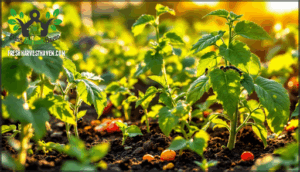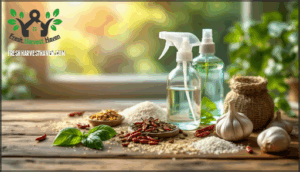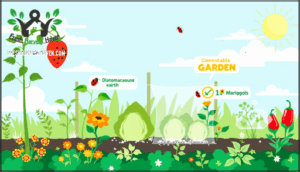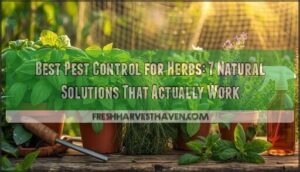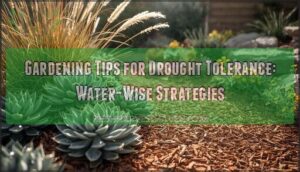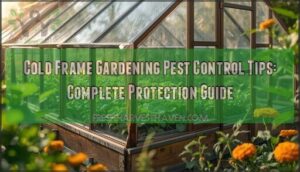This site is supported by our readers. We may earn a commission, at no cost to you, if you purchase through links.
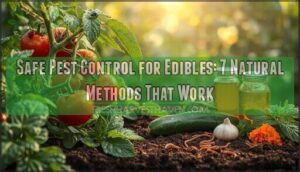
The good news? Research shows that natural pest control methods achieve 55-95% effectiveness against common garden invaders, from aphids to cutworms. By combining homemade sprays, beneficial insects, and smart planting strategies, you can protect your vegetables and herbs without compromising the safety of your harvest or the health of your soil.
Table Of Contents
- Key Takeaways
- Identifying Pests in Edible Gardens
- Natural Pest Control Methods for Edibles
- Attracting Beneficial Insects and Predators
- Companion Planting and Repellent Plants
- Physical Barriers and Protective Measures
- Safe Organic Pesticides and Repellents
- Integrated Pest Management for Edible Gardens
- Frequently Asked Questions (FAQs)
- Conclusion
Key Takeaways
- Natural pest control methods achieve 55-95% effectiveness when you combine homemade sprays, beneficial insects, physical barriers, and companion planting—creating a layered defense system that protects your harvest without chemical residues.
- Beneficial insects like ladybugs and lacewings devour up to 60 aphids daily, while strategic companion planting (basil with tomatoes, marigolds as guards) can reduce pest populations by 40-67% and boost yields by 10-25%.
- Physical barriers such as row covers, mesh fencing, and plant collars provide immediate protection with up to 100% pest exclusion when properly installed, eliminating the need for sprays during critical growth stages.
- Integrated Pest Management works best when you monitor your garden twice weekly, rotate multiple organic methods to prevent adaptation, and combine tactics—reducing severe infestations by 80% while cutting pesticide needs in half.
Identifying Pests in Edible Gardens
Before you can protect your edible garden, you need to know what you’re up against. Identifying pests early makes control much easier and keeps your vegetables and fruits safe to eat.
Here’s what to look for when checking your plants.
Common Pests Affecting Vegetables and Fruits
Who are the usual suspects raiding your vegetable gardens and fruit trees? Knowing your enemy is half the battle. The Tephritidae family alone includes over 250 economically important fruit fly species affecting crops worldwide.
Garden pests you’ll likely encounter include:
- Aphids – tiny sap-suckers that spread plant viruses and leave curled, yellowing leaves
- Flea beetles – create distinctive shot holes in peppers, cucumbers, and eggplant leaves
- Cutworms – slice through young seedlings at soil level, usually after dark
- Tomato hornworms – strip entire tomato, pepper, and eggplant plants bare
Climate change is pushing pests northward into new regions, while resistance trends show some species now shrug off common insecticides. Regular monitoring can help with early pest detection.
Signs of Pest Damage on Edible Plants
Once you spot the pests, you’ll need to recognize the plant damage they leave behind. Pest infestations announce themselves through distinctive patterns if you know what to look for.
| Damage Type | What You’ll See |
|---|---|
| Leaf Hole Patterns | Holes appear in over 68% of caterpillar-infested plants; scalloped edges signal weevils in 40% of cases |
| Distorted Plant Growth | Leaf curling affects 60% of aphid-damaged specimens; twisted leaves show up in 30% of mite attacks |
| Secretion and Webbing | Honeydew from aphids coats 80% of infestations; spider mite webs cover 85% of heavily affected crops |
Plant discoloration tells its own story. One key indicator is discoloration of leaves, which can manifest as spots or streaks. Mite feeding creates stippling on over 90% of tomato and bean leaves, while bronzing appears in 45% of severe cases. Visible pest signs include eggs clustered under foliage and white maggots in 50% of damaged root crops.
How to Monitor and Inspect for Hidden Pests
Regularly inspecting plants for pest damage catches problems early, but many pests hide where visual accuracy drops below 40%. You’ll need a layered approach combining direct observation with smart tools to reach your pest threshold before damage spreads.
Three Essential Monitoring Methods:
- Check trap placement weekly—position sticky or pheromone traps within the canopy, not above it, to boost catches by up to 60% and enable early detection of hidden populations.
- Look for biological indicators—beneficial insects like ladybugs signal natural pest control is working, while sudden absences warn of rising threats to plant health.
- Use non-destructive detection—tech monitoring with cameras or moisture sensors identifies pest-friendly conditions 72 hours before outbreaks, supporting effective pest prevention.
Natural Pest Control Methods for Edibles
You don’t need harsh chemicals to protect your vegetable garden or fruit trees from pests. Natural control methods work just as well—and they’re safer for you, your family, and the food you’re growing.
Here are three simple techniques you can start using today.
Homemade Sprays (garlic, Chili, Soap)
Your kitchen holds powerful ingredients for safe pest control for edibles. Garlic spray works like a fortress wall, achieving up to 95% aphid reduction in lab tests. Mix one crushed bulb with water, add soap, and strain before use.
Chili pepper spray boosts effectiveness—combined formulations eliminate visible pests after four applications. Soap spray suffocates soft-bodied insects on contact but use sparingly to avoid leaf burn.
Wear gloves during application, reapply weekly, and test effectiveness on a small area first.
Essential Oils Safe for Edible Crops
Beyond your pantry, you’ll find powerful organic solutions in essential oil spray formulations. Peppermint, clove, and neem oils deliver over 80% mortality against aphids and mites while meeting regulatory status as minimum-risk pesticides exempt from EPA registration.
Oil application requires proper formulation dosage—eugenol concentrations as low as 0.7 mL achieve complete pest control. Always verify crop compatibility first, since some oils inhibit germination in specific plants.
Field effectiveness increases when you blend oils with other natural pest control methods, creating thorough safe pest control for edibles without chemical residues.
Handpicking and Manual Removal Techniques
Sometimes the simplest methods work best—handpicking pests like squash bugs, hornworms, and bean beetles achieves 55-85% effectiveness with zero chemical residue. Wear gloves to protect your hands, then drop pests into soapy water to prevent their return. Target both visible insects and egg masses for true damage prevention.
Yes, labor intensity increases in larger gardens, but daily monitoring during evening hours catches problems before they spiral. This manual removal technique integrates perfectly with other safe pest control methods you’re already using.
Attracting Beneficial Insects and Predators
Your garden doesn’t have to fight pests alone—nature’s already equipped an entire army of helpful insects and animals ready to defend your edibles. These beneficial predators work around the clock, keeping harmful pest populations in check without any chemicals or sprays.
Nature’s army of beneficial insects and predators defends your edibles around the clock without chemicals or sprays
Here’s how to recruit and support these natural allies in your garden.
Introducing Ladybugs, Lacewings, and Predatory Beetles
Introducing beneficial insects creates a living defense system in your garden. Adult ladybugs devour 25–60 aphids daily, while their larvae consume ten times more. Lacewing effectiveness shines against soft-bodied pests—they reduce thrip populations by over 65%.
Predatory beetles patrol soil surfaces, targeting ground-dwelling threats. Beetle applications work best with minimal chemical interference, increasing their activity by 40% in diverse plantings.
These natural predators deliver ecological benefits that chemical sprays can’t match.
Encouraging Birds and Natural Rodent Predators
Birds serve as powerful allies in natural pest control methods for edible gardens. In field trials, bird presence reduced cabbageworm and diamondback moth populations by 33%, while gardens with native plants saw a 30% drop in insect pests.
Installing nest boxes can quadruple insectivorous bird populations—California vineyards saw Western Bluebirds increase tenfold, consuming 2.4 times more pests than control areas.
Adding raptor perches for natural rodent predators boosts presence by nearly 98%, creating predator impact that reduces foraging pressure on crops.
Creating Habitats for Beneficial Species
Think of your garden as a living ecosystem where beneficial insects thrive when you give them the right home. Flower strips cut pest larvae by 40% and adult pests by 53% in nearby crops. Hedgerow benefits include year-round shelter and food for natural predators like ground beetles and lacewings.
Cover crops provide habitat complexity that boosts beneficial insect populations while suppressing weeds. Even small spaces work—one 108 m² garden hosted 154 insect species.
Companion planting with diverse native plants strengthens this network, creating ladybug habitats and attracting beneficial insects naturally.
Companion Planting and Repellent Plants
Some plants do double duty in your garden—they grow food while naturally keeping pests at bay. Pairing the right companions can turn your edible beds into a self-defending system without sprays or chemicals.
Here’s how to use strategic planting to outsmart common garden pests.
Best Companion Plants for Pest Control
Companion planting works like creating a living defense system in your garden. Basil and tomatoes form a powerhouse duo, slashing hornworm populations by 52% and boosting yields by up to 25%. Onions and carrots protect each other too, cutting carrot fly damage by 67%.
Marigolds act as broad-spectrum guardians, reducing nematodes by 40–60% and repelling whiteflies. Nasturtiums draw pests away like a magnet, capturing 72% of aphid infestations.
Aromatic herbs—rosemary, thyme, catnip—create protective barriers while attracting beneficial insects.
Planting Strategies to Deter Common Pests
How you arrange plants matters as much as which ones you choose. Intercropping—mixing different crops in the same space—reduces pest populations by up to 65%, particularly against cabbage moths and squash beetles. Trap cropping works even better: planting Blue Hubbard squash around your main crop diverts cucumber beetles by 95%. Scent masking with aromatic herbs confuses pests, cutting their landing rates by 60%.
Spatial layouts matter too—alternating rows and checkerboard patterns lower pest density by 37–52% compared to uniform planting.
Edible Flowers and Herbs That Repel Insects
Beyond strategic placement, you can utilize edible flowers and herbs that naturally repel insects through their essential oils and active compounds. These repellent plants for edible gardens offer flower-based mechanisms and repellent herb efficacy that transform your garden into a self-defending ecosystem.
The following plants provide effective pest control:
- Basil and rosemary contain linalool and cineole, achieving 80–90% repellency against aphids while enhancing your kitchen.
- Marigolds emit alpha-terthienyl, cutting nematode activity by 78% in root zones.
- Lavender volatile oils reduce moth and fly populations by 65% within two days.
- Nasturtiums repel whiteflies while attracting beneficial hoverflies, boosting predator presence by 45%.
Interplanting these edible repellent systems with your vegetables creates multi-species protection—basil, marigold, and rosemary together reduce aphid incidence by 58% in tomato plots. Geographic suitability matters: lavender adapts across zones 2–11, while basil thrives in zones 10–11.
Beyond pest control, these companion planting strategies deliver pollination benefits, increasing bee visits by 25–40% and improving overall crop productivity by 10–15%.
Physical Barriers and Protective Measures
Sometimes the best defense is a good fence—or net, or cover. Physical barriers act like shields around your edibles, keeping pests out without chemicals or sprays.
Here are three types of protection you can set up in your garden.
Row Covers, Mesh Bags, and Garden Netting
Row covers made from spun-bonded polyethylene or polypropylene create physical barriers that block pests while letting 70–95% of light through. These lightweight materials can cut pest infestations by up to 100% when you seal edges tight at planting. Just remember to remove covers during flowering so pollinators can access your crops.
Mesh bags work beautifully for protecting individual fruits on trees, while garden netting keeps birds and rabbits away from berries and vegetables without blocking sunlight.
Critter Cages and Fencing for Rodents
Sturdy wire mesh fencing with 1/4-inch openings stops rodents from squeezing through, while a burrowing prevention depth of 12–18 inches underground blocks tunneling. Stainless steel hardware cloth offers fence material longevity beyond 15 years and resists chewing.
Structural design standards recommend posts spaced 8–10 feet apart and a 3-foot height above ground.
Multi-barrier systems combining surface and below-ground mesh reduce breach rates by over 60%, preventing garden damage to your edible plants more effectively than single-layer protection alone.
Plant Collars and Raised Beds for Added Protection
Plant collars create a tight seal around seedlings that stops cutworms and slugs cold. Aluminum foil collars prevent up to 95% of cutworm damage, while raised beds slash slug activity by half and fungal diseases by 40%.
Here’s how to get the most from pest exclusion:
- Collar Material Types: Use cardboard tubes, aluminum flashing, or duct tape (sticky-side-out for trapping)—over 70% of organic gardeners prefer biodegradable options
- Installation Guidelines: Insert collars 1 inch below soil and extend 1–2 inches above at transplant time
- Raised Bed Impact: Build beds 12–24 inches high and pair with collars for 20% greater harvest yields
These physical barriers direct water to roots while shielding fragile transplants from wind, boosting survival rates up to 30%. Additional benefits include reduced need for chemical controls and support for pollinator safety in your edible garden.
Safe Organic Pesticides and Repellents
Sometimes nature needs a gentle nudge to stay in balance. When physical barriers aren’t enough, organic pesticides and repellents step in to protect your harvest without compromising safety.
Here’s what works when you need a little extra help keeping pests at bay.
Neem Oil, Diatomaceous Earth, and Horticultural Oils
When pests threaten your vegetables or fruits, these three organic-certified tools offer powerful protection. Neem oil disrupts over 200 pest species—including aphids, whiteflies, and beetles—at concentrations as low as 0.3 ppm, achieving up to 90% mortality without harmful residues. Diatomaceous earth works through physical desiccation, delivering 90% control of soft-bodied pests within 72 hours. Horticultural oils suffocate mites, scales, and aphids with 95% effectiveness, evaporating within 48 hours.
| Product | Best For | Application Method | Preharvest Interval |
|---|---|---|---|
| Neem Oil | Whiteflies, aphids, thrips, beetles | Spray at 0.3+ ppm concentration | 0-7 days |
| Diatomaceous Earth | Slugs, flea beetles, crawling insects | Dust dry on plant surfaces | 0 days |
| Horticultural Oil | Spider mites, mealybugs, scale insects | Spray below 90°F temperature | 0 days |
Apply these during cool morning hours, wash produce thoroughly before eating, and follow label guidelines for safe, residue-free harvests.
Organic Insecticidal Soaps and Sprays
Organic insecticidal soap works by suffocating soft-bodied pests like aphids and whiteflies through physical disruption rather than chemical toxicity. You’ll find potassium salts of fatty acids most effective at C10-C11 carbon chain lengths, achieving significant leaf damage reduction in field trials.
Apply during cool morning hours for maximum pest contact, though soap efficacy drops against hard-bodied insects. These soaps integrate seamlessly into organic production systems with very low oral toxicity, but avoid using dish detergents on edibles—they’re neither FDA-approved nor safe for direct food contact.
Natural Repellents for Rodents and Larger Pests
Peppermint oil shows initial promise against rodents, but studies confirm effects often fade within two weeks as pests habituate.
Combining essential oils with capsaicin sprays, repellent plant borders like marigold and allium, and ultrasonic devices delivers stronger results—reducing activity by 70–90%.
However, rain diminishes botanical repellent sprays by up to 70%, requiring frequent reapplication.
Combined repellent approaches with humane trapping offer the most effective nontoxic methods for sustainable rodent control in edible gardens.
Integrated Pest Management for Edible Gardens
You don’t need to pick just one method when protecting your edible garden from pests. Integrated Pest Management combines several safe strategies into a system that’s stronger than any single approach.
Here’s how to build a pest control plan that suits your garden’s specific needs.
Combining Multiple Safe Control Methods
Think of integrated pest management like building a fortress—you’re not relying on one wall but layering multiple defenses for maximum protection. A comprehensive approach combines manual pest removal (used by 73% of IPM farmers), physical barriers like row covers (63% adoption), and beneficial insects (41% usage) to create method synergy that’s more effective than any single tactic.
These integrated strategies for pest control for edible gardens work together, with natural pest control methods and companion planting for pest control forming an adaptive IPM system that adjusts as conditions change.
Crop Rotation and Sanitation Practices
Rotating your crops between different plant families can reduce soil-borne pest populations by up to 80%. When you shift corn to soybeans, you interrupt the corn rootworm’s lifecycle, causing sharp population declines.
Garden hygiene matters too—cleaning out storage areas and removing old plant debris cuts pest refuge by 96%.
This combination of crop rotation and sanitation practices boosts yields by 27–48% while slashing pesticide needs in half, giving you disease suppression and pest reduction through sustainable gardening methods.
Monitoring Effectiveness and Adapting Strategies
After establishing solid foundation practices, you’ll want to track what’s working. Check your garden twice weekly to spot pest patterns early—this approach cuts severe infestations by 80%. Here’s your monitoring system:
- Pest Population Baselines: Use sticky traps to count pests; treat when you hit 5–10 per card weekly
- Technology Tracking Efficacy: Smartphone IPM apps reduce pesticide use by 25–40% through targeted timing
- Control Intervention Evaluations: Reassess every 7–10 days; organic sprays achieve 70–90% control against soft-bodied pests
- Adjusting Field Performance: Rotate organic pesticides yearly to maintain 90% effectiveness
- Documentation Feedback Integration: Digital logs improve compliance with safety limits by 20–35%
This integrated pest management cycle turns observation into action, keeping your safe pest control methods sharp.
Frequently Asked Questions (FAQs)
What soil amendments naturally discourage pest infestations?
Healthy soil naturally fights pests. Compost quality matters—rich organic matter feeds beneficial microbes that protect roots.
Balancing soil pH and nutrient balance strengthens plants, while diatomaceous earth creates barriers. Strong soil health means fewer invaders find weak targets.
How long before harvest should treatments stop?
Most organic pest control methods are food-safe up to harvest, but always check product labels for reapplication intervals.
Neem oil and insecticidal soaps usually need a 1-3 day buffer before picking your edibles.
Can UV light or heat treat pest problems?
Heat and UV light work well for pest control in edibles. Soil solarization heats soil to 108-140°F using clear plastic tarps, killing weeds, nematodes, and pathogens naturally.
This safe pest control method offers organic pest control without chemicals.
Which pests develop resistance to organic methods?
Most pests don’t develop true resistance to organic methods since natural pest control uses rotation strategies and Integrated Pest Management.
Cross-resistance is rare with physical barriers and beneficial insects, unlike chemical pesticides requiring constant resistance monitoring.
How does weather affect natural pest control?
Weather acts like a dial controlling pest control effectiveness. Rain impact washes away organic sprays, requiring reapplication. Temperature effects determine pest activity levels and spray efficacy. Humidity influence affects how solutions adhere to plants.
Conclusion
Think of your edible garden as a living ecosystem, not a battleground. When you stack safe pest control methods for edibles—companion planting beside beneficial insects, physical barriers paired with natural sprays—you’re building defenses that actually strengthen over time.
That community gardener? She now scouts twice weekly, planted marigolds between her tomatoes, and keeps neem oil handy. Her harvest tripled.
Your garden doesn’t need chemical warfare; it needs the patient, layered protection that turns pests into minor inconveniences rather than crop-destroying catastrophes.

